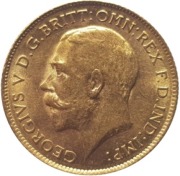 The 1926 Half-Sovereign - South Africa
The 1926 Half-Sovereign - South AfricaThe 1926 South African Half-Sovereign depicts Benedetto Pistrucci’s famous portrayal of St George slaying the dragon on the reverse of the coin.
The small letters 'SA' above the date indicates the sovereign was produced in the South African Mint.
806,540 half sovereigns were struck at the Pretoria Mint in 1926.
 King George V’s portrait by Bertram Mackennal can be seen on the obverse of the coin.
King George V’s portrait by Bertram Mackennal can be seen on the obverse of the coin.Image credit: M J Hughes Coins
Mintage: 806,540 (may include coins in sets)
Minted at The Royal Mint
Below are some coins currently being offered on eBay. As an eBay Partner, We may be compensated if you make a purchase.
 George V was King of the United Kingdom and the British Dominions, and Emperor of India, from 6 May 1910 until his death in 1936 and was King during World War 1. George was the second son of Albert Edward, Prince of Wales (later King Edward VII), and grandson of Queen Victoria. After his death he was succeeded by his eldest son, Edward VIII.
George V was King of the United Kingdom and the British Dominions, and Emperor of India, from 6 May 1910 until his death in 1936 and was King during World War 1. George was the second son of Albert Edward, Prince of Wales (later King Edward VII), and grandson of Queen Victoria. After his death he was succeeded by his eldest son, Edward VIII. In 1919-20, the Silver price rose dramatically so .925 silver coins began to made in 0.500 siver. Gold Sovereigns were produced in large quantities early in George's reign - over 30 million in 1911 and again in 1912, although there was no bullion sovereigns issued 1918-1924 (Commonwealth mints did continue mintage).
The Half-Sovereign wa introduced a long time ago, in 1544 during the reign of Henry VII. However it was discontinued in 1604 (along with full sovereigns) and no more were minted until 1817. Production ended again in 1926 (1933 in Australia) and except for a few special issues during the Coronation years, it was 1980 when we saw half-sovereigns again.
As the value is half of one sovereign, that gives the half-sovereign a face value of half a pound or ten shillings - 50p in post-decimal money, although you're going to have to pay somewhat over the gold price if you want to buy one.
The Obverse is the Monarch's head (George V) and on modern half-sovereigns the Reverse is most often St George and the Dragon (usually the Benedetto Pistrucci version), although other backs have been used.
Specifications for 1926 Half-Sovereign - South Africa
- Weight: 3.99 g
- Diameter: 19.30 mm
- Thickness: 0.99 mm
- Purity: 22 carat = 91.67% (11/12ths gold, 1/12th copper. Adding copper makes the coin more scratch and dent resistant)
- Gold Content: 3.6575 g = 0.1176 troy ounce
- Face value: £0.50 = 10 shillings (decimal: 50 pence)
- Monarch: George V
- These specifications apply to half-sovereigns from 1817.
History
Up until 1604 there was a coin called the English gold sovereign and in 1816 when there was the "Great Recoinage" the name was revived. At that time standard gold (22 carat) was valued at £46 14s 6d per troy pound; this meant a £1 coin needed to weigh 123.2744783 grains or 7.988030269 g. The weight is still the same today.
As a historical note: to maintain the Gold Standard, in 1816 the value of silver was set at 66 shillings for one troy pound and silver coins were only legal for denominations up to £2. The diameter of a half-sovereign is 19.3mm and is only slightly smaller than a full sovereign (22.05mm) so first appearance may confuse inexperienced buyers. You can see in the image on the right, the half-sovereign on the right hand side is quite similar to the full sovereign on the left.
The diameter of a half-sovereign is 19.3mm and is only slightly smaller than a full sovereign (22.05mm) so first appearance may confuse inexperienced buyers. You can see in the image on the right, the half-sovereign on the right hand side is quite similar to the full sovereign on the left.
While you can buy half-sovereigns, many collectors only own them as part of a set.
Formed in the reign of Alfred the Great about the year 886, during the period 1279-1812 it was generally referred to as The Tower Mint as it was housed at the Tower of London. The Master of The Royal Mint has included famous figures such as Sir Isaac Newton.
Since 2010 it has operated as Royal Mint Ltd, a company owned by HM Treasury, under an exclusive contract to supply all coinage for the UK although it also produces medals and coins for other countries. It is currently located at Llantrisant, Wales.
The coins of the South African rand are part of the physical form of South Africa's currency, the South African rand. In 1961, South Africa replaced the pound with a decimal currency: 100 cents (100c) = 1 rand (R1), 1 rand being valued at 10 shillings and 1 cent at 1.2 pence.
The Krugerrand is one of the World's most famous gold coins, being 1oz of fine gold.
As an eBay Partner, We may be compensated if you make a purchase.







